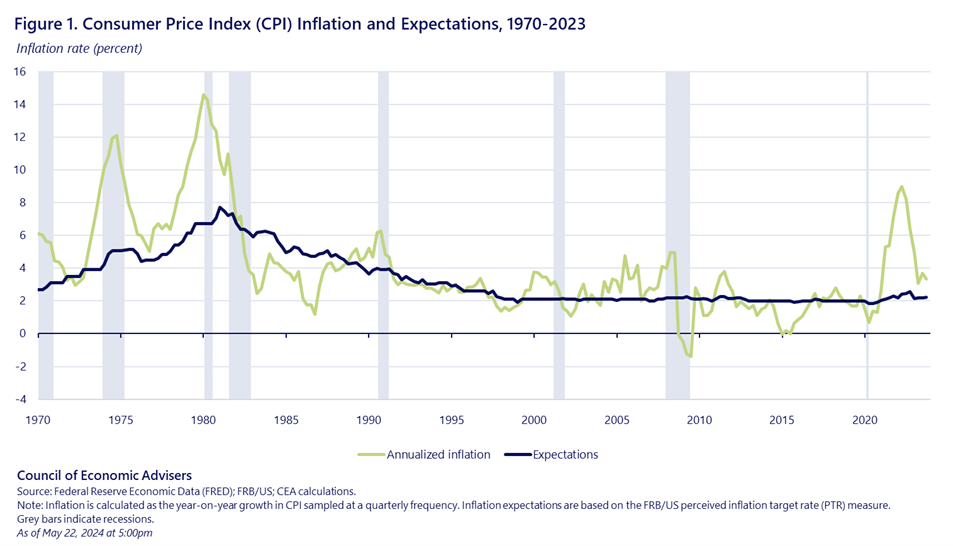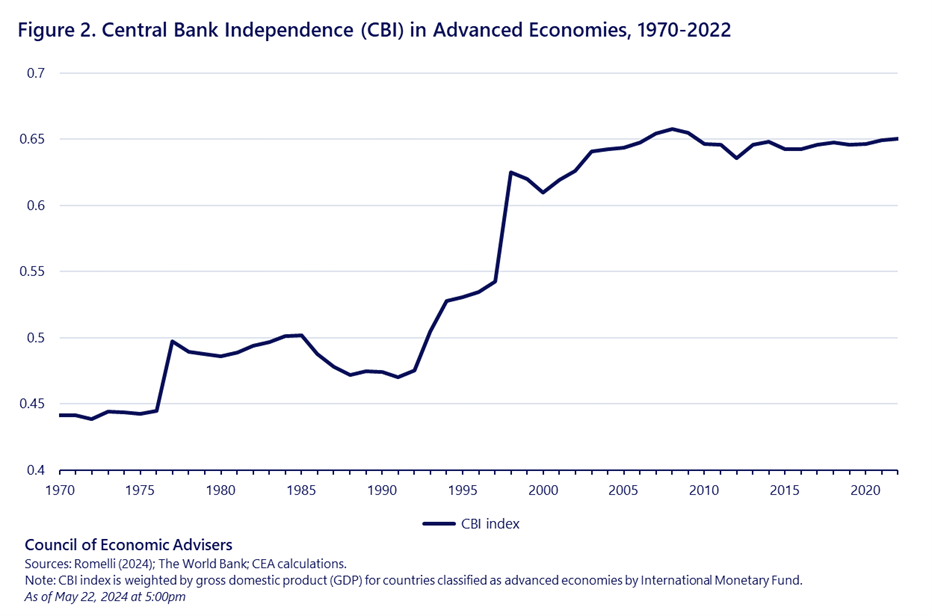The Importance of Central Bank Independence
The Biden-Harris administration has consistently elevated the importance of an independent central bank. Given that this issue has come up in various settings, CEA thought this was a good moment to explain what central bank independence (CBI) is and why it is so important.
An independent central bank is one that can carry out monetary policy without political interference. In an important distinguishing factor, governing bodies (typically national legislatures) legitimately dictate the goals or mandates of central banks, which, in the U.S. case, are maximum employment and price stability. But CBI requires that the Federal Reserve’s operational activities to achieve its dual mandate occur without political pressure or interference.
Research, theory, and evidence all reveal that a central bank’s ability to carry out monetary policy without political interference is a critical component of its ability to control inflation. Because this result is widely understood, nearly all advanced economies and many developing countries are now governed by independent central banks whose governing bodies decide monetary policy without political input, approval, or fear of reprisal.[1]
Central Bank Independence and Inflation Expectations
During the inflationary period of the 1970s and early 1980s, long-term inflation expectations became unanchored, meaning that they rose persistently, thus making the Fed’s job of containing inflation significantly more challenging. Figure 1 shows that inflation expectations rose with inflation in the 1970s and persisted through the early 1980s. In contrast, starting around 2000, expectations were well anchored. In other words, they were relatively insensitive to inflation ups and downs and remained close to the Fed’s inflation target.[2]
When inflation spiked again in recent years due to the pandemic and the ensuing shocks to global supply chains, inflation expectations remained anchored. As CEA showed in a recent analysis, supply-chain normalization played an important role in the significant disinflation shown at the end of the figure. But the durability of the anchoring was also in play and has made the Fed’s job of bringing inflation back down less economically painful than it could have been.

A central bank’s credibility is bolstered by its independence and such credibility is also key to maintaining long-term, anchored expectations. When credibility is undermined by political influence, people, firms, and others who set prices are less likely to believe the central bank’s commitment to lower inflation, which in turn can induce higher inflation. Former Fed chair Ben Bernanke explains: “A central bank subject to short-term political influences would likely not be credible when it promised low inflation, as the public would recognize the risk that monetary policymakers could be pressured to pursue short-run expansionary policies that would be inconsistent with long-run price stability.”
Central Bank Independence and Time Inconsistency
Bernanke’s reference to short-term influences is germane to another problem that CBI solves: the time-inconsistency problem, borne of the fact that central bank policies operate over a considerably longer time frame than politically-motivated policies. A non-independent central bank can face political pressure to quickly goose the economy for political reasons, as when President Nixon pressured then Fed chair Arthur Burns to engineer a favorable economy in time for the 1972 presidential election. But monetary policy takes a longer time (often referred to as “long and variable lags”) to have its intended impact. CBI gives the Fed the insulation it needs to implement policy over longer time horizons, without reacting to near-term political pressure.[3]
Central bank independence separates monetary policy from fiscal policy and thus protects political leaders from the temptation to erode the value of public debt through inflation. During World War II, for example, the Federal Reserve pegged Treasury yields to lower levels to help reduce the cost of financing the war. After the war, between 1946 and 1947, inflation soared to 17 percent and the Fed sought to resume its independence to tame inflation. However, in the executive branch, President Truman and Treasury Secretary John Snyder tried to maintain the lower interest rate peg to maintain lower costs for war debt. The disagreement was eventually resolved with the 1951 Treasury-Federal Reserve Accord, which restored the Fed’s ability to independently set interest rates.
The Evolution of Central Bank Independence
A global movement toward central bank independence took shape in the wake of inflation spikes in the 1970s and 1980s. In the United States, Congress formally established the Federal Reserve’s mandate of ensuring full employment and price stability and took steps to insulate it from political interference through the Federal Reserve Reform Act of 1977. Other countries followed suit. The Bank of England and the Bank of Japan gained independence in 1997. The European Central Bank was established as an independent central bank in 1998, replacing national central banks in European economies, some of which were subject to varying degrees of political influence. Figure 2 shows that CBI has become much more prevalent among advanced economies.

Empirical evidence shows the evolution toward central bank independence has coincided with a long-term decline in inflation in advanced economies and corresponds to well-anchored long-term expectations.[4] Because of these macroeconomic benefits, governments around the world continue to increase central bank independence: a study of 370 central bank reforms from 1923 to 2023 finds a renewed global commitment to central bank independence since 2016.
We in the Biden administration are highly motivated by this history and will continue our unwavering support for CBI. History could not be clearer regarding the lasting and damaging inflationary consequences of ignoring this lesson or reversing the hard-earned progress of the past half century.
[1] See, among others, Alesina and Summers (1993); Cukierman, Webb, and Neyapti (1992); Garriga and Rodriguez (2023); and Unsal, Papageorgiou, and Garbers (2022). See Adrian, Khan, and Nemard (2024) for a discussion of CBI measures.
[2] Of course, anchored expectations and Federal Reserve policies were likely not the only force that kept inflation volatility lower in the mid-1980s through 2007 period that has come to be known as the Great Moderation. Additional factors, such as relatively smaller macroeconomic shocks likely also played a role (Bernanke 2004).
[3] See, for example, Crowe and Meade (2007); Kydland and Prescott (1977); and Barro and Gordon (1983).
[4] Parkin and Bade (1978) were the first to identify a negative cross-sectional relationship between central bank independence and inflation among a select group of advanced economies. Canonical papers on this topic by Cukierman, Webb and Neyapti (1992) and Alesina and Summers (1993) further solidified this finding using broader samples. More recent studies have exploited variation in measures of central bank independence over time to identify the temporal relationship between changes in central bank independence and inflation. In a sample of 96 developing countries between 1980 and 2014, Garriga and Rodriguez (2023) found that increases in central bank independence were associated with lower price volatility. Unsal and Papageorgiou (2022) studied a sample of 50 countries from 2007 to 2021 and show that strong central bank independence scores helped to keep inflation expectations low.
